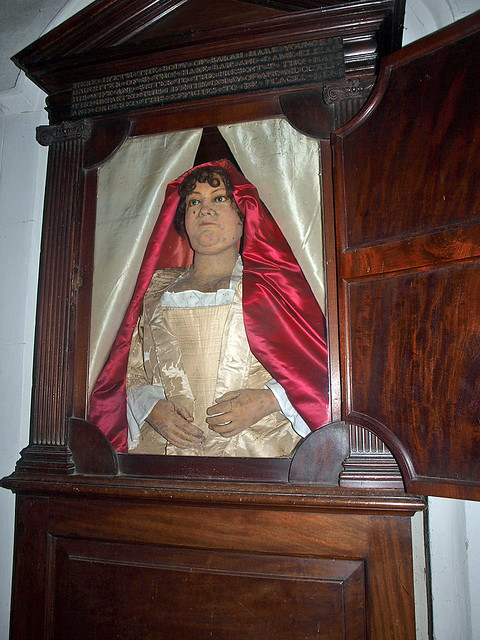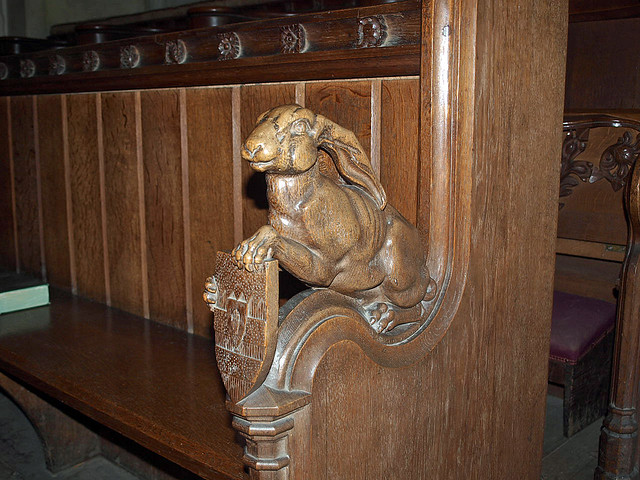Whilst the main body of the church is predominantly a Victorian build it is not without interest, with a fine set of Charles II arms, misericords, two good Victorian bench-ends [a hare and a hind] and a heavily restored sedilia, the Hare north chapel is where the action is. Quite apart from Sarah it is rammed with Hare memorials and is quite splendid.
HOLY TRINITY. Of carstone. W tower with renewed Norman windows and a wide Norman arch towards the nave. The rest of the tower Perp, with big brick buttresses. The church itself by Raphael Brandon, 1848-9. W of the porch on the N side one window in the Norman style, probably based on the existence of one here in the old church. Also of the old church the early C14 arch of the N doorway and the E.E. sedilia and piscina, these however completely renewed. - ROYAL ARMS. Of Charles II, well carved. - (STALLS. In the chancel. Two with MISERICORDS.) - Hare Chapel to the N, 1624, of brick. In it the Hare MONUMENTS. Sir Ralph d. 1623 [actually more likely to be Sir Ralph d. 1601]. Alabaster. Tomb-chest and upper structure with two columns and obelisks at the top. Much strapwork - a lively design. - Sir Thomas d. 1693. Semi-reclining figure with Roman armour and a wig. No back architecture. Thickly fluted cornice at the top of the base. - Susanna d. 1741. By Peter Scheemakers. Semi-reclining in loose draperies. Classical reredos-background with two cherubs’ heads in clouds. White and grey marble. - Mary d. 1801. Standing woman by an urn. By M. Daniell. - Sir Thomas d. 1834. Tablet of white marble. Charity and probably Faith and Hope, and between them two inscriptions. By William Theed jun. - Also tablets d. 1597 and d. 1619.*
* Also in the Hare Chapel WAX EFFIGY of Sarah Hare d. 1744, aged eighteen. She is dressed in her normal clothes. The poor girl died from blood poisoning after having pricked her finger while busy on some needlework. Surround with pilasters and a pediment.
STOW BARDOLPH. In an oak case in the Hare Chapel of this church is the wax figure of Mistress Sarah Hare, whose untimely fate might have served as a subject for one of Maria Edgeworth’s Moral Tales. We are told that she was sewing on a Sunday and a prick of her needle caused her death! (We have seen a similar story on a stone in Westminster Abbey.) Wearing the fine dress of her Georgian day (she died in 1744) Sarah Hare lies in wax, locked in her case, hidden from view.
Here is one of many memorials to the Hares whose story is linked with this village, which lies so charmingly among the woodlands on the busy road to Downham Market, looking across to Wimbotsham’s tower a few fields away. For nearly 400 years the Hares have been lords of the manor, living here through 17 reigns. One in the 17th century was a great lover of trees, and he planted cedars abundantly. Their dark green masses adorn the grounds of the hall, a fine house which they have twice rebuilt, first soon after the Armada, and again in 1875. Sir Ralph, who was “remarkable for his charities,” has a marble monument in the church and another memorial in the almshouses he founded in 1603 for six poor persons. They stand at a shaded corner by the fine gates of the hall.
It was the 16th century Nicholas Hare who built the extraordinary chapel, bigger than the chancel, which accommodates the squire’s pew as well as the monuments and flags, and the coloured shields on the borders of the fine roof. The sculptured marble monuments of Sir Thomas and Sir George with their wives and daughters, and the Scheemaker figure of Margaret Hare of 1760, are among others which keep their memory green.
The aisleless church is by the rectory, which has a fine old cedar on its lawn. Though much restored and made partly new, it keeps its massive tower with a wide Norman arch, and two Norman windows, its top storey being 15th century. The remarkable feature of the tower are the stone steps outside, leading to a priest’s room. The 13th-century triple sedilia and the double piscina have five stepped arches, and in a low window is the Madonna.
We see a hare and a hound holding shields in the chancel seats, with 12 old fleur-de-lys bench-ends. The modern screen has arches with tiny heads and a vine cornice. There is an old stone coffin in the churchyard.
In the little church at Stow Bridge, a mile or two away, are a window and a brass commemorating the Revd. J. W. Adams, who was vicar here from 1895 to 1902. As an army chaplain serving with Lord Roberts he won the V.C., the first padre ever to do so. He won it on the road from Kabul to Kandahar, by plunging into a ditch deep with water into which some horsemen had fallen with their horses over them. He saved their lives and they escaped with the enemy pressing a few yards behind.
Here is one of many memorials to the Hares whose story is linked with this village, which lies so charmingly among the woodlands on the busy road to Downham Market, looking across to Wimbotsham’s tower a few fields away. For nearly 400 years the Hares have been lords of the manor, living here through 17 reigns. One in the 17th century was a great lover of trees, and he planted cedars abundantly. Their dark green masses adorn the grounds of the hall, a fine house which they have twice rebuilt, first soon after the Armada, and again in 1875. Sir Ralph, who was “remarkable for his charities,” has a marble monument in the church and another memorial in the almshouses he founded in 1603 for six poor persons. They stand at a shaded corner by the fine gates of the hall.
It was the 16th century Nicholas Hare who built the extraordinary chapel, bigger than the chancel, which accommodates the squire’s pew as well as the monuments and flags, and the coloured shields on the borders of the fine roof. The sculptured marble monuments of Sir Thomas and Sir George with their wives and daughters, and the Scheemaker figure of Margaret Hare of 1760, are among others which keep their memory green.
The aisleless church is by the rectory, which has a fine old cedar on its lawn. Though much restored and made partly new, it keeps its massive tower with a wide Norman arch, and two Norman windows, its top storey being 15th century. The remarkable feature of the tower are the stone steps outside, leading to a priest’s room. The 13th-century triple sedilia and the double piscina have five stepped arches, and in a low window is the Madonna.
We see a hare and a hound holding shields in the chancel seats, with 12 old fleur-de-lys bench-ends. The modern screen has arches with tiny heads and a vine cornice. There is an old stone coffin in the churchyard.
In the little church at Stow Bridge, a mile or two away, are a window and a brass commemorating the Revd. J. W. Adams, who was vicar here from 1895 to 1902. As an army chaplain serving with Lord Roberts he won the V.C., the first padre ever to do so. He won it on the road from Kabul to Kandahar, by plunging into a ditch deep with water into which some horsemen had fallen with their horses over them. He saved their lives and they escaped with the enemy pressing a few yards behind.



No comments:
Post a Comment